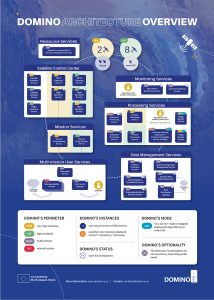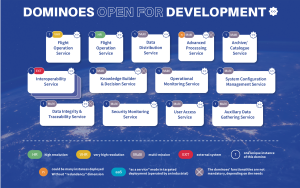Earth observation is entering a new era, where satellite infrastructure is orchestrated rather than owned. At the heart of this transformation is the European initiative Domino-E, which is reimagining how we task satellites, deliver data and enable insight – faster, smarter and more collaboratively than ever before.
Earth observation (EO) has traditionally relied on vertically integrated infrastructures – each mission supported by its own dedicated ground segment; each satellite tied to proprietary systems. While effective in earlier decades, this model is increasingly limited in an era of satellite constellations, agile tasking, and rising demand for high-resolution, real-time data.
Emerging technical, economic, and policy drivers – cloud-native software, private-sector innovation, and New Space commercialisation – are now pushing the sector toward modularity. The future EO ground segment is taking shape as a flexible, service-oriented architecture.
At the heart of this shift is Domino-E, a Horizon Europe project re-imagining EO ground infrastructure through modular, federated services. Instead of monolithic systems, Domino-E introduces ‘Dominoes’ – function-specific software modules, from scheduling to data delivery, that can be independently developed and flexibly combined. These building blocks underpin a scalable GSaaS framework, adaptable to diverse missions and stakeholders.
Architectural transformation and interoperability
Traditional EO systems are typically organised around tightly coupled workflows – one satellite, one control system, one antenna network. This coupling limits responsiveness, restricts reuse across missions, and forces each new operator to start from scratch. These systems are not only expensive to build but also difficult to evolve once deployed.
Domino-E’s architecture takes the opposite approach. It decouples functionality through standardised interfaces and API-driven communication, enabling independent deployment, configuration, and scaling of each service. A Domino might manage satellite coverage optimisation, coordinate ground station bookings, or serve as a user interaction layer. Crucially, they can be hosted across different clouds, platforms, and jurisdictions, enabling distributed EO workflows that are adaptable and vendor-neutral.
The abstraction of complexity is a key benefit. Users do not need to know where a Domino is deployed, who operates the satellite, or which antenna receives the signal. What matters is the service level and the standard interface that guarantees performance, compatibility, and trust.
How federation transforms EO from pipelines into marketplaces
The real strength of Domino-E lies in its federated architecture. Here, multiple actors – government agencies, private companies, SMEs – contribute Dominoes to a shared operational pool. These are orchestrated dynamically based on mission needs, resource availability, or priority. This multiplicity allows Earth observation to shift from linear workflows to dynamic marketplaces, where scheduling, tasking, and data delivery are treated as services. A single infrastructure can support diverse users – defence agencies, agri-tech startups, disaster response teams – via a common backbone of interoperable modules. The assets remain distinct but operate collaboratively.

Gauthier Picard, co-designer of the Coverage Service within Domino-E, explains how the federation model handles complex acquisition planning. He said: “The idea is not to control everything centrally, but to make the whole ecosystem interoperable and efficient. When a user requests imagery over a wide area, the Coverage Service automatically partitions the region into smaller zones and distributes tasking to various mission chains. These may involve different satellites, operators, or even sovereign infrastructures.” Picard emphasises the intelligence embedded in the system, saying: “It’s about optimising coverage plans based on capacity, visibility, and user constraints. The Coverage Service enables coordinated acquisition across a heterogeneous, distributed landscape – without requiring the user to manage the underlying complexity.”
When a user requests a large-area acquisition, the Coverage Service partitions it and delegates tasks to multiple mission chains, public or private. This increases speed and efficiency while reducing redundancy. By solving capacity fragmentation, federation boosts Return on Investments: satellites and ground stations are no longer idle – they are optimised.
Rethinking ground infrastructure: From ownership to on-demand access
The architectural transition is especially visible in the rise of Ground Stations as a Service (GSaaS). GSaaS in the Domino-E context treats ground station time as a rentable, shareable resource. Antennas can be scheduled, booked, and utilised by multiple stakeholders in a time-sliced, mission-specific manner. Instead of owning antennas, operators can now rent access via a time-sliced, virtualised model. Domino-E’s Satellite Communication and Resource Management Service (SCRMS), developed by the Polish SME ITTI, automates this interaction. It matches satellites to ground stations by computing orbital windows, bandwidth needs, and operational constraints. Jakub Rezler, architect of the Satellite Communication and Resource Management Service (SCRMS), describes how this core Domino orchestrates access to ground stations. He said: “The novelty of the Domino-E approach is that it treats satellite-ground contact as a shared, schedulable resource. SCRMS evaluates orbital dynamics, visibility windows, satellite’s contact needs, chance of inter-satellite jamming, and service priorities to schedule ‘meetings’ between satellites and available ground stations – automatically and in real time.”
Rezler added that this opens the architecture to more players, saying: “Operators no longer need to own an entire network. They can rent access through a standardised interface. This lowers entry barriers, increases system utilisation, and supports scalable GSaaS deployment across institutional and commercial missions alike.” The system resembles the shift seen in computing before, from private servers to elastic cloud capacity. The result is more than efficiency. GSaaS democratises access. Startups and smaller space operators – previously priced out of dedicated infrastructure – can now access world-class EO capabilities through standardised, pay-as-you-go services.
Making satellites talk: How Domino-E is democratising space access
A third key innovation within Domino-E is the development of a virtual assistant designed to make Earth observation services more accessible to non-experts. Built by Tilde, a Latvian SME and leader in language technologies, this conversational interface acts as a bridge between end users and Domino-E’s modular, federated back end. While traditional systems often require technical knowledge to define tasking parameters or configure acquisition plans, the Virtual Assistant enables users to express their requirements in plain language.
For example, someone working in a local municipality might request an image of a flooded area without knowing which satellite to use or how to initiate a tasking request. The assistant interprets these inputs, interacts with underlying Domino services such as the Coverage Service or SCRMS, and delivers the result efficiently and transparently. No need for radio frequency expertise or satellite control room access – the system abstracts that complexity and delivers actionable data on demand.
The architecture supporting this assistant was designed from the outset for multilingual and domain-specific interaction, drawing on years of experience in speech recognition, natural language understanding, and real-time dialogue systems. It is not merely a user interface – it is a service layer that embodies the Domino philosophy: modular, intelligent, and interoperable. By turning complex planning processes into intuitive conversations, the Virtual Assistant lowers the entry barrier to high-performance EO infrastructure. It enables broader adoption, democratises access, and ensures that the power of federated Earth observation systems can reach actors far beyond the traditional space sector.
Architecture as a strategic tool for sovereignty and resilience
The implications of modular federation aren’t just technical – they’re geopolitical. Domino-E enables governments to compose mission chains from standardised parts, ensuring compliance and control while avoiding full-stack ownership. Governments no longer need to own every link in the chain; instead, they can embed requirements on data governance, encryption, or service localisation into procurement. They can use modularity to foster industrial coordination and support a pan-European EO strategy.
The policy implications extend further. Federated EO also levels the playing field. SMEs can enter the ecosystem by contributing niche Dominoes – analytics engines, scheduling tools, or visualisation interfaces – without needing to operate full missions. Public tenders and certifications can reinforce this inclusion. Crucially, federation supports sovereign autonomy. A defence agency may run its Dominoes in a secure enclave, while civilian actors use the same architecture in public clouds. Both retain control over access and compliance. And when crisis strikes, this architecture shines: shared scheduling, bandwidth, and analytics services can be activated across agencies in real time. What’s required isn’t trust in a single operator, but trust in the standard.
Redefining the role of enterprises as orchestrators
As modular architectures gain traction, businesses are discovering that the value no longer lies solely in owning assets or selling software. Increasingly, the highest value is found in orchestration—managing complexity, enabling interoperability, and delivering performance to users who care more about outcomes than infrastructure. While in the legacy model, businesses delivered hardware, software, or consulting into a single mission’s value chain, in the federated model, they can assume vastly different positions – as operators, orchestrators, or experience providers. This means enterprises must evolve their strategic posture.
Some may choose to remain infrastructure specialists – designing, manufacturing, or hosting Dominoes within the federation. Others may move up the stack, offering orchestration platforms that configure workflows across Dominoes based on user needs, resource availability, or mission urgency. A third category of enterprise players will focus on user experience. Their competitive edge lies not in bandwidth or latency, but in clarity – how well they abstract complexity for the end user.
Summary: From infrastructure to intelligence
Earth observation is undergoing a profound redesign. What was once a static, tightly coupled system is becoming dynamic, modular, and intelligent. Domino-E is not merely a technical upgrade – it is a platform for economic transformation. In this new paradigm, enterprises act not just as vendors but as ecosystem builders. Governments become curators of capability. Innovation becomes more inclusive, resilient, and fast. The result is not just better EO infrastructure – it is a smarter, more resilient EO economy.

The most fundamental shift enabled by Domino-E is, however, conceptual. EO is no longer about infrastructure – it’s about intelligence. The question isn’t how many satellites you operate, but how effectively you turn data into insight. Domino-E’s modular design supports this shift. It enables AI-based scheduling, predictive resource management, and user-personalised services. It changes how systems are judged – from imaging capacity to decision speed. The new frontier is defined by the fluidity of collaboration – the ease with which actors, assets, and services can interoperate across institutional, commercial, and geographic boundaries.
Meanwhile, the Domino-E prototypes are up and running, and the consortium is actively seeking partners to expand the federation. If you are a ground station operator, mission planner or developer of AI-driven analytics, you are welcome to collaborate with the modular ecosystem. Find out more at www.domino-e.eu.
Acknowledgements
DOMINO-E is a European Research and Innovation Action co-funded by the European Union under the Horizon Europe programme (Grant Agreement No. 101082230). Coordinated by Airbus Defence and Space, the project brings together six partners from five countries, including organisations from industry, research, and the SME sector. The consortium is working collaboratively to design and prototype a modular, federated ground segment for Earth observation services, with a focus on enabling broader participation of SMEs in this development.
Views and opinions expressed are, however, those of the author(s) only and do not necessarily reflect those of the European Union or the European Health and Digital Executive Agency (HaDEA). Neither the European Union nor the granting authority can be held responsible for them.
Please note, this article will also appear in the 23rd edition of our quarterly publication.
Source link

